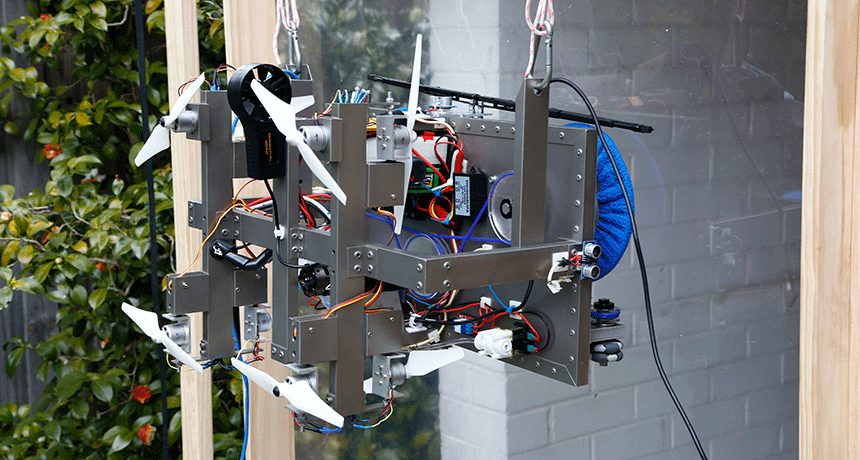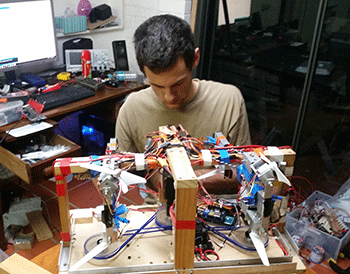This robot can wash a skyscraper’s windows
Teen’s invention can spritz, wipe and squeegee clean the dirty panes on a high-rise building

This robot can wash a skyscraper’s windows even in moderate winds, its Australian inventor reports.
O. Nicholls
By Sid Perkins
Washing windows on a skyscraper is a dirty job. Hanging off the side of a building can also be incredibly dangerous, notes Oliver Nicholls, 19. So this 12th-grader from Sydney, Australia, invented a robot to tackle the job.
Some recent incidents inspired his project. In one, a couple of high-rise window washers were standing on a platform that collapsed. No one died, but the pair were seriously injured. Oliver also witnessed someone fall and break his leg while cleaning a glass awning over the entrance to a building.
The new robot is about the size of a medium-sized picnic cooler and weighs 12 to 15 kilograms (26 to 33 pounds). It’s designed to dangle off the side of a building from ropes or cables, just as current window-washing platforms do. A hose carries water to the robot. A cable delivers it electric power.

The robot cleans windows much as a human would. But the device is controlled by a computer program. First, the robot sprays a small amount of water onto a window. Then, it moves up and down and across the window. Microfiber-covered buffers rub across the glass to scrub any dirt away. As the robot moves, it uses a windshield-wiper–style squeegee to remove any water left behind.
The computer controls the robot’s up-and-down movements by adjusting the ropes or cables from which the device hangs. When the robot needs to move from one window to another, a set of propellers kicks into gear. They push the robot a short distance away from the building, while the cables slide along a railing to carry the robot over to the next window. Then, as a different set of propellers holds the robot tight against the window, the cleaning cycle repeats.
Oliver tested his robot by cleaning sample windows he’d built in his backyard. The robot’s propellers can hold the robot against a building even in winds as high as 45 kilometers (28 miles) per hour, the teen reports. He performed those tests using his family’s leaf blower.
Oliver showcased the robot here, this week, at the Intel International Science and Engineering Fair (ISEF). The science-fair competition was created by Society for Science & the Public, or SSP, and is sponsored this year by Intel. The 2018 event brought together almost 1,800 finalists from 81 countries. (SSP also publishes Science News for Students and this blog).
Besides limiting the chance of injury, this window-washing robot could save building owners a bit of money. If commercialized, Oliver estimates it would cost about $11,000 to buy. That’s about the same cost as hiring a crew to clean a 7-story building, he notes. So Oliver suspects his robot might be able to pay for itself after cleaning just one such building.
________________
Update: On Friday May 18, this robot project was awarded top prize in ISEF’s Robotics and Intelligent Machines category. Even more impressively, Oliver was named winner of the Gordon E. Moore award, ISEF’s top prize. Named for Intel’s co-founder, his award comes with $75,000.
Follow Eureka! Lab on Twitter







